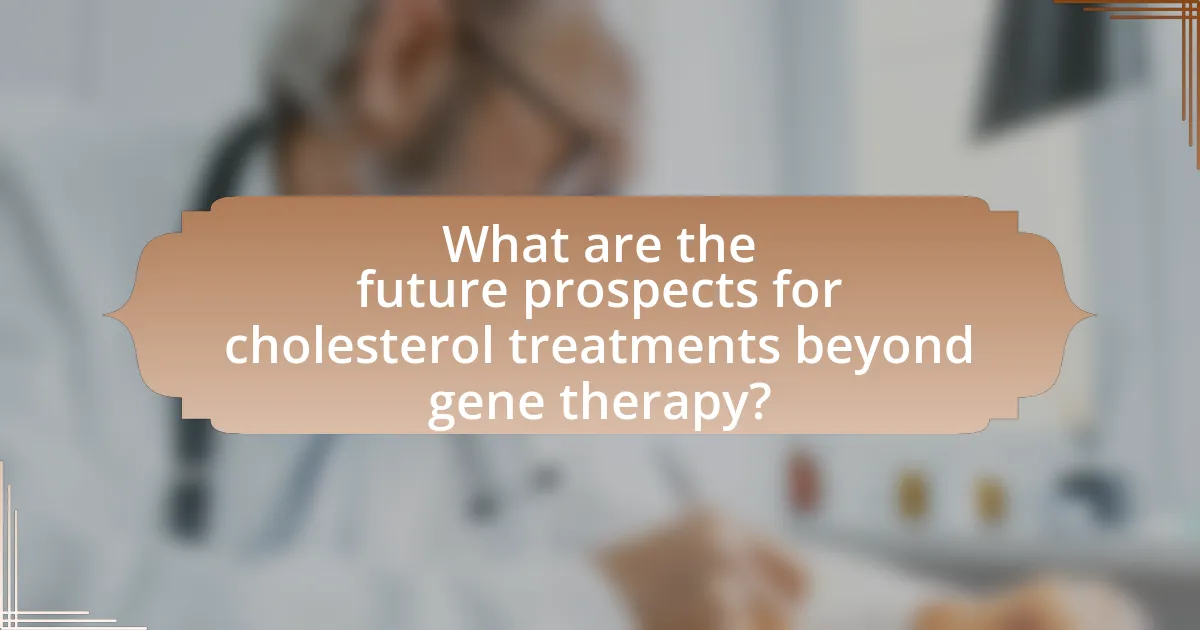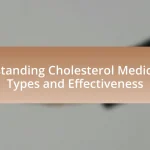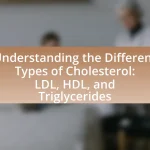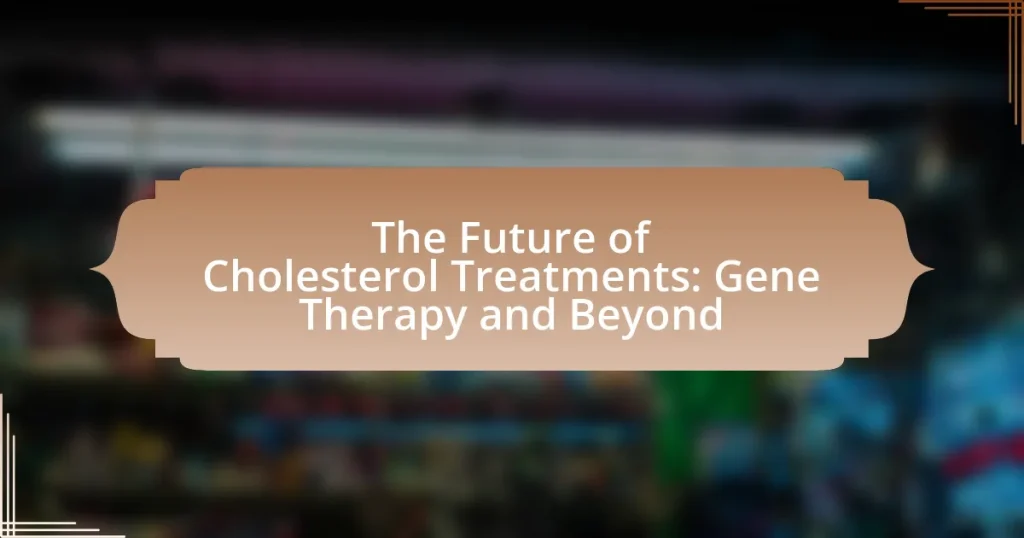The article focuses on the evolving landscape of cholesterol treatments, highlighting the significance of gene therapy as a promising approach to managing high cholesterol levels. It outlines current treatment options, including statins, bile acid sequestrants, cholesterol absorption inhibitors, and PCSK9 inhibitors, while discussing their mechanisms, efficacy, and limitations. The article also explores the potential advantages of gene therapy over traditional methods, emphasizing its ability to target genetic factors contributing to cholesterol disorders. Additionally, it addresses the challenges and regulatory hurdles associated with new therapies, as well as practical steps individuals can take to manage their cholesterol levels effectively.

What are the current cholesterol treatments available?
Current cholesterol treatments include statins, bile acid sequestrants, cholesterol absorption inhibitors, and PCSK9 inhibitors. Statins, such as atorvastatin and simvastatin, are the most commonly prescribed medications, effectively lowering LDL cholesterol levels by inhibiting the enzyme HMG-CoA reductase. Bile acid sequestrants, like cholestyramine, work by binding bile acids in the intestine, leading to increased cholesterol conversion to bile acids. Cholesterol absorption inhibitors, such as ezetimibe, reduce the absorption of dietary cholesterol in the intestines. PCSK9 inhibitors, including alirocumab and evolocumab, are newer injectable medications that significantly lower LDL cholesterol by enhancing the liver’s ability to remove LDL from the bloodstream. These treatments are supported by clinical studies demonstrating their efficacy in reducing cardiovascular events associated with high cholesterol levels.
How do traditional cholesterol treatments work?
Traditional cholesterol treatments primarily work by lowering levels of low-density lipoprotein (LDL) cholesterol in the bloodstream. Statins, the most commonly prescribed medications, inhibit the enzyme HMG-CoA reductase, which plays a crucial role in cholesterol synthesis in the liver. This reduction in cholesterol production leads to an increase in the liver’s uptake of LDL from the blood, thereby lowering overall LDL levels. Clinical studies have shown that statins can reduce the risk of cardiovascular events by approximately 20-30% in high-risk populations, demonstrating their effectiveness in managing cholesterol levels and improving heart health.
What are the different classes of cholesterol-lowering medications?
The different classes of cholesterol-lowering medications include statins, bile acid sequestrants, cholesterol absorption inhibitors, fibrates, and PCSK9 inhibitors. Statins, such as atorvastatin and simvastatin, work by inhibiting HMG-CoA reductase, which reduces cholesterol production in the liver. Bile acid sequestrants, like cholestyramine, bind bile acids in the intestine, leading to increased cholesterol conversion to bile acids. Cholesterol absorption inhibitors, such as ezetimibe, block the absorption of cholesterol from the diet. Fibrates, including fenofibrate, primarily lower triglyceride levels and can modestly increase HDL cholesterol. Lastly, PCSK9 inhibitors, like alirocumab and evolocumab, enhance the liver’s ability to remove LDL cholesterol from the blood. Each class has distinct mechanisms and clinical applications, supported by extensive research demonstrating their efficacy in managing cholesterol levels and reducing cardiovascular risk.
What are the common side effects associated with these treatments?
Common side effects associated with cholesterol treatments, particularly gene therapy, include injection site reactions, flu-like symptoms, and potential liver enzyme elevations. Injection site reactions may manifest as pain, redness, or swelling at the site of administration. Flu-like symptoms can encompass fever, fatigue, and muscle aches, which are often transient. Liver enzyme elevations, observed in some gene therapies, indicate potential liver stress and require monitoring. These side effects are documented in clinical trials and studies, such as those published in the Journal of the American College of Cardiology, which detail the safety profiles of emerging cholesterol therapies.
Why is there a need for new cholesterol treatments?
There is a need for new cholesterol treatments due to the limitations of existing therapies in effectively managing cholesterol levels and reducing cardiovascular disease risk. Current treatments, such as statins, do not work for everyone and can have side effects, leading to non-adherence in patients. Additionally, a significant portion of the population remains at risk for heart disease despite treatment, with studies indicating that nearly 50% of individuals with high cholesterol do not achieve target levels with standard therapies. New treatments, including gene therapy, offer the potential for more personalized and effective management of cholesterol, addressing the unmet needs of patients who are unable to achieve optimal outcomes with existing options.
What limitations do current treatments have?
Current treatments for cholesterol management, such as statins and other lipid-lowering medications, have several limitations. These include side effects like muscle pain and liver damage, which can lead to discontinuation of therapy in some patients. Additionally, not all individuals respond adequately to these treatments, resulting in persistent high cholesterol levels despite adherence. Furthermore, current therapies do not address the underlying genetic factors contributing to cholesterol disorders, limiting their effectiveness in certain populations. Studies indicate that approximately 30% of patients do not achieve target LDL cholesterol levels with standard treatments, highlighting the need for more innovative approaches like gene therapy.
How do lifestyle factors influence cholesterol management?
Lifestyle factors significantly influence cholesterol management by affecting lipid levels in the body. Diet, physical activity, and weight management play crucial roles; for instance, a diet high in saturated fats can raise LDL cholesterol, while a diet rich in fruits, vegetables, and whole grains can lower it. Regular physical activity helps increase HDL cholesterol, which is beneficial for heart health. Furthermore, maintaining a healthy weight can improve cholesterol levels, as obesity is linked to higher LDL cholesterol and lower HDL cholesterol. Studies indicate that lifestyle modifications can lead to a 10-20% reduction in LDL cholesterol levels, demonstrating the effectiveness of these factors in cholesterol management.

What is gene therapy and how does it relate to cholesterol treatment?
Gene therapy is a medical technique that involves modifying or manipulating genes to treat or prevent diseases. In the context of cholesterol treatment, gene therapy aims to address genetic factors that contribute to high cholesterol levels, such as familial hypercholesterolemia, by introducing or altering genes responsible for lipid metabolism. For instance, recent studies have shown that gene therapy can effectively lower LDL cholesterol levels by targeting specific genes, such as PCSK9, which plays a crucial role in cholesterol regulation. This approach has the potential to provide long-lasting effects compared to traditional cholesterol-lowering medications, as evidenced by clinical trials demonstrating significant reductions in cholesterol levels following gene therapy interventions.
How does gene therapy work in the context of cholesterol management?
Gene therapy works in cholesterol management by targeting and modifying genes responsible for lipid metabolism. This approach aims to correct genetic defects that lead to high cholesterol levels, such as familial hypercholesterolemia, by introducing functional copies of genes or using techniques like CRISPR to edit existing genes. For instance, studies have shown that gene therapy can effectively lower low-density lipoprotein (LDL) cholesterol levels by enhancing the liver’s ability to clear LDL from the bloodstream, as demonstrated in clinical trials where patients experienced significant reductions in cholesterol levels after receiving gene therapy interventions.
What are the key mechanisms of gene therapy for cholesterol reduction?
The key mechanisms of gene therapy for cholesterol reduction include the modulation of gene expression, targeted delivery of therapeutic genes, and the use of RNA interference. Gene therapy can enhance the expression of genes that promote cholesterol uptake and metabolism, such as the LDL receptor gene, which helps clear low-density lipoprotein from the bloodstream. Additionally, targeted delivery systems, such as viral vectors, facilitate the precise introduction of these therapeutic genes into specific tissues, improving efficacy. RNA interference can also be employed to silence genes responsible for cholesterol synthesis, thereby reducing overall cholesterol levels. These mechanisms have been supported by studies demonstrating significant reductions in cholesterol levels in animal models and early human trials, highlighting their potential in future cholesterol treatments.
What types of gene therapies are currently being researched?
Currently, several types of gene therapies are being researched, including gene editing techniques like CRISPR-Cas9, gene replacement therapies, and RNA-based therapies. CRISPR-Cas9 is being explored for its potential to directly modify genes associated with cholesterol metabolism, aiming to reduce levels of low-density lipoprotein (LDL) cholesterol. Gene replacement therapies focus on delivering functional copies of genes that are deficient or mutated, which can help restore normal cholesterol processing. RNA-based therapies, such as small interfering RNA (siRNA) and antisense oligonucleotides, are being investigated for their ability to silence genes that contribute to high cholesterol levels. These approaches are supported by ongoing clinical trials and research studies that demonstrate their efficacy and safety in managing cholesterol-related conditions.
What potential advantages does gene therapy offer over traditional treatments?
Gene therapy offers several potential advantages over traditional treatments, including the ability to target the root cause of genetic disorders rather than just alleviating symptoms. This approach can lead to more effective and long-lasting solutions, as seen in conditions like familial hypercholesterolemia, where gene therapy can correct the underlying genetic defect responsible for high cholesterol levels. Additionally, gene therapy may reduce the need for lifelong medication, as it aims to provide a one-time treatment that can result in sustained therapeutic effects. Studies have shown that gene therapies can significantly lower cholesterol levels in patients, demonstrating their potential to outperform conventional therapies that often require ongoing management and may have limited efficacy.
How might gene therapy improve patient outcomes?
Gene therapy can improve patient outcomes by directly targeting and correcting genetic defects that contribute to diseases, including those affecting cholesterol metabolism. This approach allows for the potential to reduce cholesterol levels significantly, as demonstrated in clinical trials where gene therapy has successfully lowered low-density lipoprotein (LDL) cholesterol by up to 60% in patients with familial hypercholesterolemia. By addressing the root cause of genetic disorders, gene therapy not only alleviates symptoms but also reduces the risk of cardiovascular events, leading to enhanced long-term health and quality of life for patients.
What are the long-term implications of gene therapy for cholesterol levels?
Gene therapy for cholesterol levels has the long-term implication of significantly reducing the risk of cardiovascular diseases by targeting and modifying genes responsible for lipid metabolism. This approach can lead to sustained reductions in low-density lipoprotein (LDL) cholesterol, as evidenced by studies showing that gene editing techniques, such as CRISPR, can effectively lower LDL levels in animal models and early human trials. For instance, a study published in the journal Nature demonstrated that gene therapy could achieve a 60% reduction in LDL cholesterol over a prolonged period, indicating potential for lasting effects. Additionally, the long-term use of gene therapy may decrease the need for lifelong medication, thereby improving patient adherence and quality of life.

What are the future prospects for cholesterol treatments beyond gene therapy?
Future prospects for cholesterol treatments beyond gene therapy include the development of novel pharmacological agents, such as PCSK9 inhibitors, which have shown significant efficacy in lowering LDL cholesterol levels. Additionally, research is focusing on small interfering RNA (siRNA) therapies that target specific genes involved in lipid metabolism, offering a new mechanism for cholesterol management. Clinical trials have demonstrated that these treatments can lead to substantial reductions in cholesterol levels, with some studies indicating a decrease of up to 60% in LDL cholesterol. Furthermore, advancements in personalized medicine may allow for tailored treatment approaches based on individual genetic profiles, enhancing the effectiveness of cholesterol-lowering therapies.
What innovative approaches are being explored in cholesterol management?
Innovative approaches being explored in cholesterol management include gene therapy, which aims to modify genes responsible for cholesterol metabolism. Research has shown that therapies targeting the PCSK9 gene can significantly lower LDL cholesterol levels, with studies indicating reductions of up to 60% in patients. Additionally, RNA interference techniques are being developed to silence genes that contribute to high cholesterol, providing a novel method for long-term management. These advancements represent a shift towards personalized medicine in cholesterol treatment, focusing on genetic factors that influence individual responses to therapy.
How might personalized medicine change the landscape of cholesterol treatment?
Personalized medicine may revolutionize cholesterol treatment by tailoring therapies based on individual genetic profiles and risk factors. This approach allows for more effective management of cholesterol levels, as treatments can be customized to target specific pathways and mechanisms unique to each patient. For instance, genetic testing can identify individuals who are predisposed to high cholesterol due to inherited conditions, enabling healthcare providers to prescribe targeted interventions such as specific statins or novel therapies like PCSK9 inhibitors. Studies have shown that personalized approaches can lead to improved adherence and outcomes, as patients receive treatments that align with their unique biological makeup.
What role do advancements in biotechnology play in future treatments?
Advancements in biotechnology are crucial for developing future treatments, particularly in the realm of gene therapy for cholesterol management. These innovations enable precise editing of genes associated with cholesterol metabolism, allowing for targeted therapies that can significantly reduce LDL cholesterol levels. For instance, CRISPR technology has shown promise in clinical trials, demonstrating the ability to modify genes responsible for cholesterol regulation, which could lead to long-lasting effects and reduced reliance on traditional medications. This shift towards personalized medicine, driven by biotechnological advancements, is expected to enhance treatment efficacy and minimize side effects, ultimately transforming how cholesterol-related conditions are managed.
What challenges must be overcome for these future treatments to succeed?
Future cholesterol treatments, particularly gene therapy, must overcome several significant challenges to succeed. These challenges include ensuring the safety and efficacy of gene editing techniques, addressing potential off-target effects, and achieving consistent delivery of therapeutic agents to target tissues. For instance, studies have shown that while CRISPR technology holds promise, it can lead to unintended genetic modifications, which raises safety concerns (Doudna & Charpentier, 2014). Additionally, the delivery mechanisms, such as viral vectors, must be optimized to effectively reach liver cells, where cholesterol metabolism occurs, without eliciting adverse immune responses. Furthermore, regulatory hurdles and the need for long-term clinical data to demonstrate the benefits and risks of these treatments must be navigated to gain approval and acceptance in clinical practice.
What regulatory hurdles exist for new cholesterol therapies?
New cholesterol therapies face several regulatory hurdles, primarily related to safety, efficacy, and long-term effects. Regulatory agencies like the FDA require extensive clinical trials to demonstrate that these therapies are both safe and effective before approval. For instance, therapies must undergo Phase I, II, and III trials, which can take years and require significant financial investment. Additionally, the complexity of gene therapies introduces challenges in demonstrating consistent manufacturing processes and product quality, as highlighted by the FDA’s stringent guidelines on biologics. Furthermore, post-marketing surveillance is often mandated to monitor long-term effects, adding another layer of regulatory scrutiny.
How can public perception impact the acceptance of new treatments?
Public perception significantly impacts the acceptance of new treatments by influencing patient willingness to adopt innovative therapies. When the public views a treatment positively, such as gene therapy for cholesterol management, acceptance rates increase, leading to higher patient enrollment in clinical trials and greater market success. Conversely, negative perceptions, often fueled by misinformation or fear, can hinder the adoption of beneficial treatments. For instance, a survey published in the Journal of Medical Internet Research found that 70% of respondents expressed concerns about the safety of gene therapies, which directly correlated with lower acceptance rates among potential patients. Thus, shaping public perception through education and transparent communication is crucial for the successful integration of new treatments into healthcare.
What practical steps can individuals take to manage cholesterol levels effectively?
Individuals can manage cholesterol levels effectively by adopting a heart-healthy lifestyle that includes dietary changes, regular physical activity, and routine health screenings. Consuming a diet rich in fruits, vegetables, whole grains, and healthy fats, while limiting saturated and trans fats, can significantly lower LDL cholesterol levels. For instance, the American Heart Association recommends reducing saturated fat intake to less than 6% of total daily calories to help manage cholesterol. Engaging in at least 150 minutes of moderate aerobic exercise each week can also improve cholesterol levels by raising HDL cholesterol, the “good” cholesterol. Additionally, regular health screenings can help individuals monitor their cholesterol levels and make necessary adjustments to their lifestyle or seek medical advice when needed.










